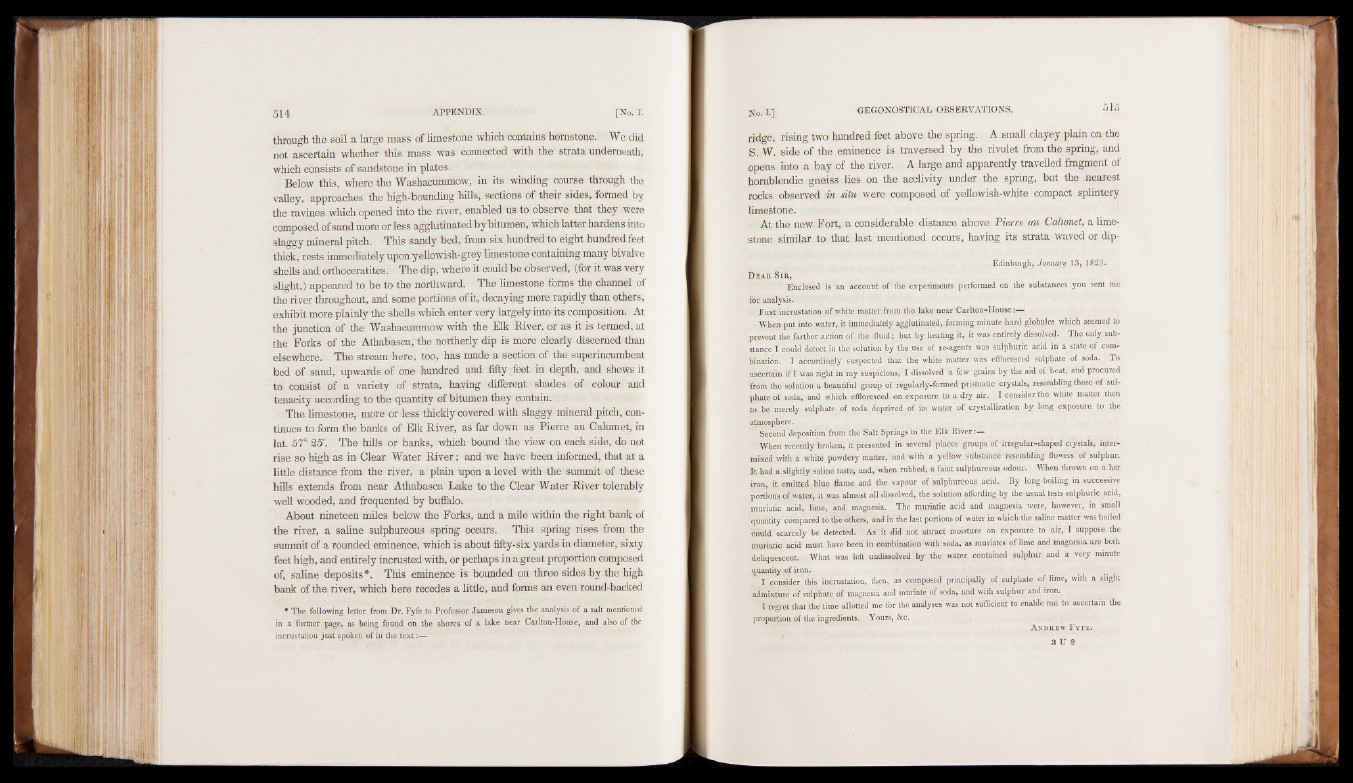
through the soil a large mass of limestone which contains hornstone. We did
not ascertain whether this mass was connected with the strata underneath,
which consists of sandstone in plates.
Below this, where the Washacummow, in its winding course through the
valley, approaches the high-bounding hills, sections of their sides, formed by
the ravines which opened into the river, enabled us to observe that they were
composed of sand more or less agglutinated by bitumen, which latter hardens into
slaggy mineral pitch. This sandy bed, from six hundred to eight hundred feet
thick, rests immediately upon yellowish-grey limestone containing many bivalve
shells and orthoceratites, The dip, where it could be observed, (for it was very
slight,) appeared to be to the northward. The limestone forms the channel of
the river throughout, and some portions of it, decaying more rapidly than others,
exhibit more plainly the shells which enter very largely into its composition. At
the junction of the Washacummow with the Elk River, or as it is termed, at
the Forks of the Athabasca, the northerly dip is more clearly discerned than
elsewhere. The stream here, too, has made a section of the superincumbent
bed of sand, upwards of one hundred and fifty feet in depth, and shews it
to consist of a variety of strata, having different shades of colour and
tenacity according to the quantity of bitumen they contain.
The limestone, more or less thickly covered with slaggy mineral pitch, continues
to form the banks of Elk River, as far down as Pierre ait Calumet, in
lat. 57° 25'. The hills or banks, which bound the view on each.side, do not
rise so high as in Clear Water River; and we have been informed, that at a
little distance from the river, a plain upon a level with the summit of these
hills extends from near Athabasca Lake to the Clear Water River tolerably
well wooded, and frequented by buffalo.
About nineteen miles below the Forks, and a mile within the right bank of
the river, a saline sulphureous spring occurs. This spring rises from the
summit of a rounded eminence, which is about fifty-six yards in diameter, sixty
feet high, and entirely incrusted with, or perhaps in a great proportion composed
of, saline deposits*. This eminence is bounded on three sides by the high
bank of the river, which here recedes a little, and forms an even round-backed
* The following letter from Dr. Fyfe to Professor. Jameson gives the analysis of a salt mentioned
in a former page, as being found on the shores of a lake near Carlton-House, and also of the
incrustation just spoken of in the text:—
ridge, rising two hundred feet above the spring. A small clayey plain on the
S. W. side of the eminence is traversed by the rivulet from the spring, and
opens into a bay of the river. A large and apparently travelled fragment of
hornblendic gneiss lies on the acclivity under the spring, but the nearest
rocks observed in situ were composed of yellowish-white compact splintery
limestone.
At the new Fort, a considerable distance above Pierre au Calumet, a limestone
similar to that last mentioned occurs, having its strata waved or dip-
Edinburgh, January 13, 1823.
D e a r S i r,E
nclosed is an account of the experiments performed on the substances you sent me
for analysis.
First incrustation of white matter from the lake near Carlton-House:—
When put into water, it immediately agglutinated, forming minute hard globules which seemed to
prevent the farther action of the fluid; but by heating it, it was entirely dissolved. The only substance
I could detect in the solution by the use of re-agents was sulphuric acid in a state of combination.
I accordingly suspected that the white matter was effloresced sulphate of soda. To
ascertain if I was right in my suspicions, I dissolved a few grains by the aid of heat, and procured
from the solution a beautiful group of regularly-formed prismatic crystals, resembling those of sulphate
of soda, and which effloresced on exposure to a dry air. I consider the white matter then
to be merely sulphate of soda deprived of its water of crystallization by long exposure to the
atmosphere.
Second deposition from the Salt Springs in the Elk River:—
When recently broken, it presented in several places groups of irregular-shaped crystals, intermixed
with a white powdery matter, and with a yellow substance resembling flowers of sulphur.
It had a slightly saline taste, and, when rubbed, a faint sulphureous odour. When thrown on a hot
iron, it emitted blue flame and the vapour of sulphureous acid. By long boiling in successive
portions of water, it was almost all dissolved, the solution affording by the usual tests sulphuric acid,
muriatic acid,, lime, and magnesia. The muriatic acid and magnesia were, however, in small
‘quantity compared to the others, and in the last portions of water in which the saline matter was boiled
could scarcely be detected. As it did not attract moisture on exposure to air, I suppose the
muriatic acid must have been in combination with soda, as muriates of lime and magnesia are both
deliquescent. What was left undissolved by the water contained sulphur and a very minute
quantity ?of iron. ; .
I consider this incrustation, then, as composed principally of sulphate of lime, with a slight
admixture of sulphate of magnesia and muriate of soda, and with sulphur and iron.
I regret that the'time allotted me for the analyses was not'sufficient to enable me to ascertain the
proportion of the ingredients. Yours, &c. Andrew Fyfe.
3 U 2